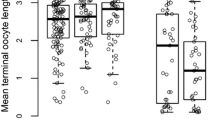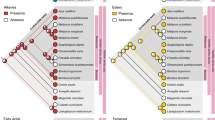Abstract
In eusocial Hymenoptera, queen control over workers is probably inseparable from the mechanism of queen recognition. In primitively eusocial bumblebees (Bombus), worker reproduction is controlled not only by the presence or absence of a dominant queen but also by other dominant workers. Furthermore, it was shown that the queen dominance is maintained by pheromonal cues. We investigated whether there is a similar odor signal released by egg-laying queens and workers that may have a function as a fertility signal. We collected cuticular surface extracts from nest-searching and breeding Bombus terrestris queens and workers that were characterized by their ovarian stages. In chemical analyses, we identified 61 compounds consisting of aldehydes, alkanes, alkenes, and fatty acid esters. Nest-searching queens and all groups of breeding females differed significantly in their odor bouquets. Furthermore, workers before the competition point (time point of colony development where workers start to develop ovaries and lay eggs) differed largely from queens and all other groups of workers. Breeding queens showed a unique bouquet of chemical compounds and certain queen-specific compounds, and the differences toward workers decrease with an increasing development of the workers’ ovaries, hinting the presence of a reliable fertility signal. Among the worker groups, the smallest differences were found after the competition point. Egg-laying females contained higher total amounts of chemical compounds and of relative proportions of wax-type esters and aldehydes than nest-searching queens and workers before the competition point. Therefore, these compounds may have a function as a fertility signal present in queens and workers.




Similar content being viewed by others
References
Ayasse M, Marlovits TC, Tengö J, Taghizadeh T, Francke W (1995) Are there pheromonal dominance signals in the bumblebee Bombus hypnorum L (Hymenoptera, Apidae). Apidologie 26(1):163–180
Ayasse M, Birnbaum J, Tengö J, van Doorn A, Taghizadeh T, Francke W (1999) Caste- and colony-specific chemical signals on eggs of the bumble bee, Bombus terrestris L. (Hymenoptera: Apidae). Chemoecology 9(3):119–126
Backhaus K, Erichson B, Flinke W, Schuchard-Ficher C, Weiber R (1987) Multivariate Analysemethoden. Springer, New York, p 404
Bloch G (1999) Regulation of queen–worker conflicts in bumble-bee (Bombus terrestris) colonies. Proc R Soc Lond B 266:2465–2469
Bloch G, Hefetz A (1999) Reevaluation of the role of mandibular glands in regulation of reproduction in bumblebee colonies. J Chem Ecol 25:881–896
Buckle GR (1982) Queen-worker behavior and nestmate interactions in young colonies of Lasioglossum zephyrum. Insect Soc 29:125–137
Buser H-R, Arn H, Guerin P, Rauscher S (1983) Determination of double bond position in mono-unsaturated acetates by mass spectrometry of dimethyl disulfide adducts. Anal Chem 55:818–822
Cahlíková L, Hovorka O, Ptáček V, Valterová I (2004) Exocrine gland secretions of virgin queens of five bumblebee species (Hymenoptera: Apidae, Bombini). Z Naturforsch C 59(7–8):582–589
D’Ettorre P, Heinze J, Schulz C, Francke W, Ayasse M (2004) Does she smell like a queen? Chemoreception of a cuticular hydocarbon signal in the ant Pachycondyla inversa. J Exp Biol 207:1085–1091
D’Etorre P, Tofilski A, Heinze J, Ratnieks FLW (2006) Non-transferable signal on ant queen eggs prevent policing evasion by cue scrambling. Naturwissenschaften 93(3):136–140
Fletcher DJC, Ross KG (1985) Regulation of reproduction in eusocial Hymenoptera. Annu Rev Entomol 30:319–343
Hefetz A, Tengö J, Lübke G, Francke W (1993) Inter-colonial and intra-colonial variations in Dufour’s gland secretion in the bumble bee species Bombus hypnorum (Hymenoptera: Apidae). In: Weise K, Gribakin FG, Renninger G (eds) Sensory systems of arthropods. Birkhauser, Basel, pp 469–480
Hefetz A, Taghizadeh T, Francke W (1996) The exocrinology of the queen bumble bee Bombus terrestris (Hymenoptera:Apidae, Bombini). Z Naturforsch 51c:409–422
Hölldobler B, Michener CD (1980) Mechanisms of identification and discrimination in social hymenoptera. In: Markl H (ed) Evolution of social behaviour hypotheses and empirical tests. Verlag Chemie GmbH, Weinheim, pp 35–58
Katayama E (1974) Egg-laying habits and brood development in Bombus hypocrita (Hymenoptera, Apidae), 1 egg-laying habits of queens and workers. Kontyû 42(4):416–438
Katzav-Gozansky T, Soroker V, Hefetz A (2002) Honeybees Dufour’s gland—idiosyncrasy of a new queen signal. Apidologie 33:525–537
Katzav-Gozansky T, Boulay R, Soroker V, Hefetz A (2004) Queen-signal modulation of worker pheromonal composition in honeybees. Proc R Soc Lond B 271:2065–2069
Katzav-Gozansky T, Boulay R, Soroker V, Hefetz A (2006) Queen pheromones affecting the production of queen-like secretion in workers. J Comp Physiol 192:737–742
Keller L, Nonacs P (1993) The role of queen pheromones in social insects: queen control or queen signalling? Anim Behav 45:787–794
Liebig J, Peeters C, Oldham NJ, Markstädter C, Hölldobler B (2000) Are variations in cuticular hydrocarbons of queens and workers a reliable signal of fertility in the ant Harpegnathos saltator? Proc Natl Acad Sci USA 97:4124–4131
Lopez-Vaamonde C, Koning JW, Brown RM, Jordan WC, Bourke AF (2004) Social parasitism by male-producing reproductive workers in a eusocial insect. Lett Nat 430:557–560
Malka O, Shnieor S, Hefetz A, Katzav-Gozansky T (2006) Reversible royalty in worker honeybees under the queen influence. Behav Ecol Sociobiol 61:465–473
McLafferty FW, Stauffer DB (1989) The Wiley NBS registry of mass spectral data. Wiley, New York
Michener CD (1974) The social behavior of the bees. Harvard University Press, Cambrige, UK, p 404
Norusis MJ (1993a) SPSS for Windows: base system user’s guide, release 6.0. SPSS, Chicago, IL
Norusis MJ (1993b) SPSS for Windows: professional statistics, release 6.0. SPSS, Chicago, IL
Plettner E, Slessor KN, Winston ML, Robinson GE, Page RE (1993) Mandibular gland components and ovarian development as measures of caste differentiation in the honey bee (Apis mellifera L.). J Insect Physiol 39(3):235–240
Röseler PF (1985) A technique for year-round rearing of Bombus terrestris (Apidae, Bombini) colonies in captivity. Apidologie 16:165–169
Röseler PF, Röseler I (1977) Dominance in bumblebees. In: Proc Int IUSSI Congr, vol 8, Wageningen, pp 232–235
Röseler PF, van Honk CGJ (1990) Castes and reproduction in bumblebees. In: Engels W (ed) Social insects, an evolutionary approach to castes and reproduction. Springer, Berlin, pp 147–166
Röseler PF, Röseler I, van Honk CGJ (1981) Evidence for inhibition of corpora allata activity in workers of Bombus terrestris by a pheromone from the queen’s mandibular glands. Experientia 37:348–351
Seeley TD (1979) Queen substance dispersal by messenger workers in honeybee colonies. Behav Ecol Sociobiol 5:391–415
Slessor KN, Kaminski L-A, King GGS, Borden JH, Winston ML (1988) Semiochemical basis of the retinue response to queen honey bees. Nature 332:354–356
Tengö J, Hefetz A, Bertsch A, Schmitt U, Lübke G, Francke W (1991) Species specificity and complexity of Dufour’s gland secretion of bumble bees. Comp Biochem Physiol 99B:641–646
van Doorn A (1988) Reproductive dominance in bumble-bees: an etho-physiological study. Thesis, University of Utrecht, The Netherlands
van Doorn A (1989) Factors influencing dominance behaviour in queenless bumblebee workers (Bombus terrestris). Physiol Entomol 14:211–221
van Doorn A, Heringa J (1986) The ontogeny of a dominance hierarchy in colonies of the bumblebee Bombus terrestris (Hymenoptera, Apidae). Insect Soc 33:3–25
van Honk CGJ, Velthuis HHW, Röseler P-F, Malotaux ME (1980) The mandibular glands of Bombus terrestris queens as a source of queen pheromones. Entomol Exp Appl 28:191–198
van Honk CG, Röseler PF, Velthuis HHW, Hoogeveen JC (1981) Factors influencing the egg laying of workers in a captive Bombus terrestris colony. Behav Ecol Sociobiol 9:9–14
Velthuis HHW (1976) Egg laying, aggression and dominance in bees. In: Proc XI Int Congr Entomol Washington DC, pp. 436–449
Winston ML, Higo HA, Slessor KN (1990) Effect of various dosages of queen mandibular gland pheromone on the inhibition of queen rearing in the honey bee (Hymenoptera: Apidae). Ann Entomol Soc Am 83(2):234–238
Acknowledgments
We wish to thank the German Research Foundation (DFG) for financial support (AY 12/2-1). A. Sramkova would like to thank the Friedrich Naumann Stiftung for financial support. W. Francke likes to thank the Fonds der Chemischen Industrie for financial support. All experiments comply with the current laws of the country in which they were performed: in this case, Germany.
Author information
Authors and Affiliations
Corresponding author
Rights and permissions
About this article
Cite this article
Sramkova, A., Schulz, C., Twele, R. et al. Fertility signals in the bumblebee Bombus terrestris (Hymenoptera: Apidae). Naturwissenschaften 95, 515–522 (2008). https://doi.org/10.1007/s00114-008-0353-4
Received:
Revised:
Accepted:
Published:
Issue Date:
DOI: https://doi.org/10.1007/s00114-008-0353-4




